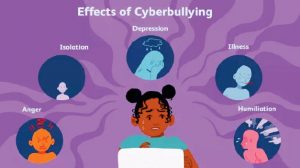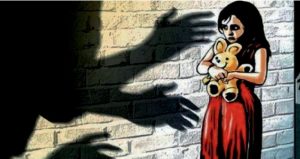
There are several laws prohibiting cybercrimes against women who are 18 years of age and above, but they also cover those women who are below 18 years of age.
According to a recent survey conducted by Tata Consultancy Service, 7 out of 10 children shop online, 76 per cent of children use Facebook. 9 out of 10 children have a mobile phone. Another survey by Assocham reveals that nearly 60 per cent of Indian teenagers view 125 messages in a day.
Recent studies have led to findings that Internet addiction is on the rise among children who show an increase in signs of depression and anxiety.
Among the several threats to children online, the most common are sexual exploitation, child pornography and cyberbullying. According to a survey conducted by the Ministry of Women and Child Development in 2005, 53 per cent of the children in India were reported to have been sexually abused.
There are specific laws in India to protect children on the Internet such as a law prohibiting child pornography and sexual harassment.
(i) Child Pornography Section 67B of the IT Act, 2000 expressly prohibits child pornography. If any person publishes or transmits material depicting children in sexually explicit acts in electronic form or creates images text, calls, seeks downloads, advertises, promotes or distributes contents that depict children in an obscene manner, such person is punishable with imprisonment for a term which may extend up to 5 years and fine up to Rs10 lakhs.
(ii) Child Grooming – In case of child grooming activities, i.e. where a person entices a child into an online relationship with one or more children for a sexual explicit act or facilitates abusing children online or recording own abuse or that of others relating to sexual explicit acts with children such acts are punishable with imprisonment for a term up to 5 years and fine up to Rs.10 lakhs. In the event of second conviction, it is punishable with imprisonment for a term up to 7 years and fine up to Rs.10 lakhs.
(iii) Cyberbullying – According to the Global youth online behaviour survey conducted by Microsoft 53 per cent of children between the age 8 and 17 in India were found to be the victims of cyberbullying.
 Most of these cyberbullying cases arise out of social media encounters covering 60 per cent of these cases, whereas, mobile phones and online chatrooms comprised the second and third category totalling 40 percent of such cases. Some commonly known forms of cyberbullying are happy slapping i.e. where a mobile or camera is used to record an incident where a child is being bullied and then circulated the same on social media. Trolling is another form of cyberbullying where abusing and hurtful submissions are made online on social media.
Most of these cyberbullying cases arise out of social media encounters covering 60 per cent of these cases, whereas, mobile phones and online chatrooms comprised the second and third category totalling 40 percent of such cases. Some commonly known forms of cyberbullying are happy slapping i.e. where a mobile or camera is used to record an incident where a child is being bullied and then circulated the same on social media. Trolling is another form of cyberbullying where abusing and hurtful submissions are made online on social media.
Rumour spreading is a form of cyberbullying where gossip is spread through email, pictures or other means. A girl child is most susceptible to receiving such threats online.
(iv) Photo Morphing – Photo morphing is yet another crime targeting children particularly girl children where harmless pictures of girl children are morphed into obscene pictures and circulated online. In one such reported incident, a girl of 17 years committed suicide as her morphed picture was uploaded on Facebook along with her phone number and she had started receiving obscene calls and faced harassment.
(v) Sexting – Sexting is sending of sexually explicit messages through mobile phones. Sexting is also quite common as cybercriminals entice children to create their own selfies having obscene content and mail them instantly.
(vi) Cyberstalking– Cyberstalking is yet another rampant problem where a cybercriminal closely follows or stalks a child’s activity online causing the child harassment or inconvenience. In one such case, a 14-year-old girl from Mumbai committed suicide due to cyberstalking wherein a boy had been posting her obscene pictures on her Facebook account.
(vii) Other cybercrimes – Among other rising crimes against children are online gambling enticing children into drugs, financial frauds targeting children through fake messages known as Phishing and injecting malware in emails, electronic files for breaching the privacy of children
 Children often watch DVDs or listen to music and use the pirated versions that could contain malware infecting the device used by them.
Children often watch DVDs or listen to music and use the pirated versions that could contain malware infecting the device used by them.
Identifying theft and hacking into online accounts are other rampant problems as fake profiles of children are easily created on Social Networks by imposters and cybercriminals.
Laws combating cybercrimes against children
 India is a signatory to the Convention on the Rights of the child, 1990 (CRC) and Optional Protocol on the Sale of Children, Child Prostitution and Child Pornography. India has also ratified the Universal Declaration of Human Rights and its Covenants, the UN Convention against Transnational organised crimes and the Protocol to Prevent, Suppress and Punish Trafficking in Women and Children, SAARC Convention on Prevention and Combating Trafficking in Women And Children For Prostitution and Convention on Regional Arrangement For Promotion Of Child Welfare In South Asia And The Convention On Elimination Of All Forms Of Discriminations Against Women. To implement its mandate the National Commission for Protection of Child Rights was set up to examine the complaints of violation of child rights in India. There are two Special Acts for the protection of children in India relevant to the subject under discussion.
India is a signatory to the Convention on the Rights of the child, 1990 (CRC) and Optional Protocol on the Sale of Children, Child Prostitution and Child Pornography. India has also ratified the Universal Declaration of Human Rights and its Covenants, the UN Convention against Transnational organised crimes and the Protocol to Prevent, Suppress and Punish Trafficking in Women and Children, SAARC Convention on Prevention and Combating Trafficking in Women And Children For Prostitution and Convention on Regional Arrangement For Promotion Of Child Welfare In South Asia And The Convention On Elimination Of All Forms Of Discriminations Against Women. To implement its mandate the National Commission for Protection of Child Rights was set up to examine the complaints of violation of child rights in India. There are two Special Acts for the protection of children in India relevant to the subject under discussion.
(I) Juvenile Justice (Care & Protection of children) Act, 2015 The J.J Act, 2015 implements provision of the Convention on the Rights Of the child which India ratified in 1992. The JJ Act was enacted in 1986 amended in 2000 and the present Act is of 2015. The second chapter of Act describes general principles of care and protection of children, Principle of presumption of innocence, dignity and self -worth, safety rights to privacy and confidentiality, natural justice amongst other principles. The third chapter of the Act provides for the establishment of the Juvenile Justice Board to decide juvenile justice-related cases. It provides for setting up of observation homes and special homes for children in conflict with the law. It provides provisions for adopting child-friendly procedures for adjudication of cases, recording of testimony and evidence of children in conflict with the law. For children who are victims of crime, it provides for special care and protection measures, rehabilitation measures apart from protecting the identity of a child. It also prescribes setting up of child welfare committees for the welfare of children. The new J.J Act, 2015 provides that juveniles between 16 to 18 years committing heinous offences can be tried as adults. This development was made after the Delhi (Nirbhaya) gang rape case.
(ii) POCSO Act, 2012 to protect children from sexual abuse the POCSO Act, 2012 has been enacted. Child pornography is banned under Protection of Children from Sexual Offences Act,2012 which contains provisions against sexual assaults, sexual harassment and child pornography. Section 13 of the POCSO Act provides that whoever uses a child in any form of image for the purposes of sexual gratification which includes representing the sexual organs of a child, using a child in any real or simulated sexual acts, indecent or obscene representation of child, such person will be guilty of the offence of child pornography. Section 14 provides punishment for child pornography which would extend up to 5 years and fine on first conviction and in case of subsequent conviction imprisonment for a term up to 7 years and fine. Sections 13 and 14 are reproduced herein below for easy reference: – “Section 13. Use of child for pornographic purposes. – Whoever, uses a child in any form of media (including programme or advertisement telecast by television channels (whether or not such programme or advertisement is intended for personal use or for distribution), for the purposes of sexual gratification, which includes – (a) representation of the sexual organs of a child; (b) usage of a child engaged in real or simulated sexual acts (with or without penetration); (c) the indecent or obscene representation of a child, shall be guilty of the offence of using a child for pornographic purposes. Explanation:- For the purposes of this section, the expression “use a child” shall include involving a child through any medium like print, electronic, computer or any other technology for preparation, production, offering, transmitting, publishing, facilitation and distribution of the pornographic material.”
 (iii) Section 14 provides that the punishment for child pornography shall be imprisonment which can extend up to five years and with an imprisonment of a term which may extend up to seven years and also be liable to fine. “Section 14. Punishment for using a child for pornographic purpose. – (1) Whoever, uses a child or children for pornographic purposes shall be punished with imprisonment of either description which may extend to five years and shall also be liable to fine and in the event of second or subsequent conviction, with imprisonment of either description for a term which may extend to seven years and also be liable to fine. (2) If the person using the child for pornographic purpose commits an offence referred to in section 3, by directly participating in pornographic acts, he shall be punished with imprisonment of either description for a term which shall not be less than ten years but which may extend to imprisonment for life, and shall also be liable to fine (3) If the person using the child for pornographic purpose commits an offence referred to in section 5, by directly participating in pornographic acts, he shall be punished with rigorous imprisonment of description for a term which shall not be less than ten years but which may extend to imprisonment for life, and shall also be liable to fine. (4) If the person using the child for pornographic purpose commits an offence referred to in section 7, by directly participating in pornographic acts, he shall be punished with imprisonment of either description for a term which shall not be less than six years but which may extend to eight years, and shall also be liable to fine. (5) If the person using the child for pornographic purpose commits an offence referred to in section 9, by directly participating in pornographic acts, he shall be punished with imprisonment of either description for a term which shall not be less than eight years but which may extend to ten years, and shall also be liable to fine.” Section 15 of the POCSO Act prohibits storage of pornographic material involving a child with imprisonment up to 3 years or fine or both. The POCSO Act in Section 11 covers the several crimes targeting children online (and also offline) under the umbrella offence of sexual harassment such as child grooming, cyberstalking or other forms of child abuse including threats to use any obscene content involving a child in a sexual act. Section 12 makes sexual harassment a punishable offence with imprisonment for a term up to 3 years and fine. Section 20 of the POCSO Act puts an obligation on media, hotels, hospitals or clubs to report any material containing child pornography by contacting the police13. Such proactive provision is not found in the IT Act, 2000 as on date of writing. A person who fails to report the matter shall be punishable with imprisonment for a term of six months or a fine or both. The POCSO Act provides for the establishment of Special Codes in each District to try the offence under the Act. The National Commission for Protection of Child Rights or the State Commission for Protection of Child Rights in addition to the function assigned to them under the commission for Protection of Child Rights Act, 2005 monitors the implementation of the POCSO Act 14. The National Commission for Women has also been set up as statutory body in January 1992 under the National Commission for Women Act, 1990 to review the Constitutional and legal safeguards for women; recommend remedial legislative measures, facilitate redressal of grievances and advise the Government on all policy matters affecting women. There is greater need to set up fast track courts and special tribunals established under POCSO Act to combat rising cybercrimes against children. Many states are still under the process of establishing such tribunals. Government also needs to intensify its focus on to this area particularly in light of blue whale suicide incidents in the country to create national policies that aim to prevent and combat such cybercrimes targeting children. (iii) IT Act, 2000: – While the sections discussed earlier apply equally to girl children such as Sections 66E for invasion of privacy15 and 67A of IT Act, 2000 for prohibiting circulation or publishing of sexually explicit content, Section 67B of IT Act, 2000 particularly deals with the offence of child pornography and prohibits the same as well as the child grooming. The said Section is reproduced hereinbelow for reference: “67B.
(iii) Section 14 provides that the punishment for child pornography shall be imprisonment which can extend up to five years and with an imprisonment of a term which may extend up to seven years and also be liable to fine. “Section 14. Punishment for using a child for pornographic purpose. – (1) Whoever, uses a child or children for pornographic purposes shall be punished with imprisonment of either description which may extend to five years and shall also be liable to fine and in the event of second or subsequent conviction, with imprisonment of either description for a term which may extend to seven years and also be liable to fine. (2) If the person using the child for pornographic purpose commits an offence referred to in section 3, by directly participating in pornographic acts, he shall be punished with imprisonment of either description for a term which shall not be less than ten years but which may extend to imprisonment for life, and shall also be liable to fine (3) If the person using the child for pornographic purpose commits an offence referred to in section 5, by directly participating in pornographic acts, he shall be punished with rigorous imprisonment of description for a term which shall not be less than ten years but which may extend to imprisonment for life, and shall also be liable to fine. (4) If the person using the child for pornographic purpose commits an offence referred to in section 7, by directly participating in pornographic acts, he shall be punished with imprisonment of either description for a term which shall not be less than six years but which may extend to eight years, and shall also be liable to fine. (5) If the person using the child for pornographic purpose commits an offence referred to in section 9, by directly participating in pornographic acts, he shall be punished with imprisonment of either description for a term which shall not be less than eight years but which may extend to ten years, and shall also be liable to fine.” Section 15 of the POCSO Act prohibits storage of pornographic material involving a child with imprisonment up to 3 years or fine or both. The POCSO Act in Section 11 covers the several crimes targeting children online (and also offline) under the umbrella offence of sexual harassment such as child grooming, cyberstalking or other forms of child abuse including threats to use any obscene content involving a child in a sexual act. Section 12 makes sexual harassment a punishable offence with imprisonment for a term up to 3 years and fine. Section 20 of the POCSO Act puts an obligation on media, hotels, hospitals or clubs to report any material containing child pornography by contacting the police13. Such proactive provision is not found in the IT Act, 2000 as on date of writing. A person who fails to report the matter shall be punishable with imprisonment for a term of six months or a fine or both. The POCSO Act provides for the establishment of Special Codes in each District to try the offence under the Act. The National Commission for Protection of Child Rights or the State Commission for Protection of Child Rights in addition to the function assigned to them under the commission for Protection of Child Rights Act, 2005 monitors the implementation of the POCSO Act 14. The National Commission for Women has also been set up as statutory body in January 1992 under the National Commission for Women Act, 1990 to review the Constitutional and legal safeguards for women; recommend remedial legislative measures, facilitate redressal of grievances and advise the Government on all policy matters affecting women. There is greater need to set up fast track courts and special tribunals established under POCSO Act to combat rising cybercrimes against children. Many states are still under the process of establishing such tribunals. Government also needs to intensify its focus on to this area particularly in light of blue whale suicide incidents in the country to create national policies that aim to prevent and combat such cybercrimes targeting children. (iii) IT Act, 2000: – While the sections discussed earlier apply equally to girl children such as Sections 66E for invasion of privacy15 and 67A of IT Act, 2000 for prohibiting circulation or publishing of sexually explicit content, Section 67B of IT Act, 2000 particularly deals with the offence of child pornography and prohibits the same as well as the child grooming. The said Section is reproduced hereinbelow for reference: “67B.  Punishment for publishing or transmitting of material depicting children in the sexually explicit act, etc., in electronic form. – Whoever – (a) publishes or transmits or helps in publication of transmitted material in any electronic form which depicts children engaged in sexually explicit act or conduct; or (b) creates text or digital images, collects, seeks, browses, downloads, advertises, promotes, exchanges or distributes material in any electronic form depicting children in obscene or indecent or sexually explicit manner; or (c) cultivates, entices or induces children to online relationship with one or more children for and on sexually explicit act or in a manner that may offend a reasonable adult on the computer resource; or (d) facilitates abusing children online; or (e) record in any electronic form own abuse or that of others pertaining to sexually explicit act with children, shall be punished on first conviction with imprisonment of either description for a term which may extent to five years and with fine which may extend to ten lakh rupees and in the event of second or subsequent conviction with imprisonment of either description for a term which may extent to seven years and also with fine which may extend to ten lakh rupees; Provided that provisions of section 67, section 67A and this section does not extend to any book, pamphlet, paper, writing, drawing, painting representation or figure in electronic form – (i) the publication of which is proved to be justified as being for the public good on the ground that such book, pamphlet, paper, writing, drawing, painting representation or figure is in the interest of science, literature, art or learning or other objects of general concern; or (ii) which is kept or used for bonafide heritage or religious purposes.” In Kamesh Vaswani v UOI16, the Supreme Court dealt with a PIL seeking directions from the court to block all child pornographic websites in India. The court formed a high-level committee to suggest ways to curb and block child pornography on the internet. (iv) The Immoral Traffic Prevention Act,1956 The Immoral Traffic Prevention Act,1956 defines prostitution and sexual exploitation and abuse of persons for commercial reasons. The Act prohibits the sale, procuring or exploiting any person for prostitution. The punishment is stricter if crimes are committed against the children below 16 years of age. Section 5 of the Act states that if a person procures or induces a child for prostitution minimum term of 7 years of imprisonment is provided which can extend to life imprisonment. (v) Indian Penal Code,1860 Under Indian Penal Code,1860 (Herein after referred to as ‘IPC’) Section 292 of IPC prohibits sale, publication, distribution of obscene pictures which is punishable with a term up to 2 years and fine up to Rs.2,000/- on the first conviction. Section 293 of IPC prohibits sale, publication, circulation of obscene objects to persons below 20 years of age with a term of imprisonment up to 3 years and fine up to 2,000/- on first conviction.
Punishment for publishing or transmitting of material depicting children in the sexually explicit act, etc., in electronic form. – Whoever – (a) publishes or transmits or helps in publication of transmitted material in any electronic form which depicts children engaged in sexually explicit act or conduct; or (b) creates text or digital images, collects, seeks, browses, downloads, advertises, promotes, exchanges or distributes material in any electronic form depicting children in obscene or indecent or sexually explicit manner; or (c) cultivates, entices or induces children to online relationship with one or more children for and on sexually explicit act or in a manner that may offend a reasonable adult on the computer resource; or (d) facilitates abusing children online; or (e) record in any electronic form own abuse or that of others pertaining to sexually explicit act with children, shall be punished on first conviction with imprisonment of either description for a term which may extent to five years and with fine which may extend to ten lakh rupees and in the event of second or subsequent conviction with imprisonment of either description for a term which may extent to seven years and also with fine which may extend to ten lakh rupees; Provided that provisions of section 67, section 67A and this section does not extend to any book, pamphlet, paper, writing, drawing, painting representation or figure in electronic form – (i) the publication of which is proved to be justified as being for the public good on the ground that such book, pamphlet, paper, writing, drawing, painting representation or figure is in the interest of science, literature, art or learning or other objects of general concern; or (ii) which is kept or used for bonafide heritage or religious purposes.” In Kamesh Vaswani v UOI16, the Supreme Court dealt with a PIL seeking directions from the court to block all child pornographic websites in India. The court formed a high-level committee to suggest ways to curb and block child pornography on the internet. (iv) The Immoral Traffic Prevention Act,1956 The Immoral Traffic Prevention Act,1956 defines prostitution and sexual exploitation and abuse of persons for commercial reasons. The Act prohibits the sale, procuring or exploiting any person for prostitution. The punishment is stricter if crimes are committed against the children below 16 years of age. Section 5 of the Act states that if a person procures or induces a child for prostitution minimum term of 7 years of imprisonment is provided which can extend to life imprisonment. (v) Indian Penal Code,1860 Under Indian Penal Code,1860 (Herein after referred to as ‘IPC’) Section 292 of IPC prohibits sale, publication, distribution of obscene pictures which is punishable with a term up to 2 years and fine up to Rs.2,000/- on the first conviction. Section 293 of IPC prohibits sale, publication, circulation of obscene objects to persons below 20 years of age with a term of imprisonment up to 3 years and fine up to 2,000/- on first conviction.













